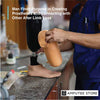These Electronic Socks Help Prevent Foot Complications in People With Diabetes
People who have diabetes and nerve and blood vessel damage often have a specific way of walking that can lead to foot complications. Identifying these walking patterns is crucial to prevent serious outcomes such as amputation.

Researchers in the Republic of Korea developed an electronic sock that can accurately detect and diagnose these gait abnormalities. This innovative sock is equipped with pressure sensors to identify abnormal walking patterns and recommend specialized training to prevent severe complications like amputation.
Diabetes and changes in walking
According to one of the inventors, Ki Hong Lee of Chonnam National University Hospital in Gwangju, people with diabetes tend to put pressure on the ball of the foot rather than the heel when they walk. This unique walking pattern can lead to ulcers, which may become infected. In a press release, Lee said it’s crucial to identify this issue early to provide preventative interventions.
Foot problems are pretty common in individuals with diabetes due to the damage caused by high blood sugar to the nerves and blood vessels. Symptoms such as numbness, tingling, and pain can be hard to detect early. Small changes in pressure distribution on the foot can result in ulcers and infections, potentially leading to amputation.
The electronic sock
The electronic sock created by Lee and his colleagues can continuously monitor the foot and is specifically designed to detect changes that may go unnoticed by patients.
Lee and his colleagues tapped 20 individuals with and 20 without diabetes to test the electronic sock. The sock was fitted with a ballistocardiogram (BCG) sensor, a device that captures body movements caused by the mechanical activity of the heart. This sensor, integrated into the sock, measured pressure and heart rate for 40 seconds while the participants were standing and 40 seconds while walking. The researchers then assessed the participants’ feet for signs of nerve and blood vessel damage.
The electronic sock, equipped with a ballistocardiogram (BCG) sensor, was tested for its precision and reliability. The sensor, which captures body movements caused by the mechanical activity of the heart, measured pressure and heart rate for 40 seconds while the participants were standing and 40 seconds while walking.
The researchers conducted a comparison of each participant's ECG readings with the BCG readings from the sock. They discovered that the heart rate measurements from the BCG sock were almost identical to those from the ECG. This indicates that the sock is an accurate tool for measuring heart rate.
The study's results were presented at the European Heart Rhythm Association 2024 scientific meeting, a prestigious international conference that brings together leading experts in cardiovascular health. The researchers demonstrated that the sock could differentiate between participants with and without diabetes. Notably, participants with diabetes exerted more pressure on the ball of the foot.
The study then compared the findings of diabetic participants with and without nerve and circulatory system damage. Interestingly, there were no noticeable differences in pressure distribution between patients with or without nerve damage, but there was a discernible contrast among those diagnosed with blood vessel damage.
The findings indicated that the electronic sock could identify diabetic patients and singling out individuals with diabetes and poor circulation.
According to Lee, this device could play a crucial role in diagnosing and preventing the deterioration of foot issues, such as ulcers and infections. By rapidly assessing whether a patient requires gait training, the sock can help prevent the progression of these complications. Moreover, the electronic sock could provide feedback on the effectiveness of such training, allowing for adjustments and improvements in the treatment plan.
Next steps
The researchers’ plans involve reducing costs and creating devices customized to each individual’s foot. Their ultimate objective is to enhance the electronic sock to the point where it can be comfortably integrated into the daily lives of many.










































































